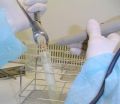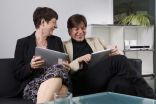(Press-News.org) Physicists Sergei Filippov (MIPT and Russian Quantum Center at Skolkovo) and Mario Ziman (Masaryk University in Brno, Czech Republic, and the Institute of Physics in Bratislava, Slovakia) have found a way to preserve quantum entanglement of particles passing through an amplifier and, conversely, when transmitting a signal over long distances. Details are provided in an article published in the journal Physical Review A (see preprint).
Quantum entangled particles are considered to be the basis of several promising technologies, including quantum computers and communication channels secured against tapping. Quantum entangled particles are quantum objects that can be described in terms of a common quantum state. Two quantum entangled particles can be in different places, at any distance from each other, but they still are to be considered as a whole. This effect has no analogues in classical physics, and it has been actively studied for the past few decades.
Physicists have learned to entangle photons and have found application for them, including opticalfiber communication channels which are impossible to tap. When trying to intercept the transmission of data over such a channel, quantum entanglement of photons is inevitably destroyed and the legitimate recipient of the message immediately detects interference.
In addition to this, quantum entanglement allows for carrying out quantum teleportation, wherein a quantum object, for example, an atom, in a certain state in one laboratory transmits its quantum state to another object in another laboratory. It is quantum entangled particles that play the key role in this process, and it is not necessarily about the quantum entanglement of the atoms between which the transmission of the state takes place. The latter atom becomes absolutely identical to the former one, which in its turn transfers into a different state during the teleportation. If all atoms of an object were transferred like this, the second laboratory would have its exact copy.
The laws of quantum mechanics do not allow for the teleportation of objects and people, but it is already possible to quantum teleport single photons and atoms, which opens up exciting opportunities for the creation of new computing devices and communication lines. Due to specific quantum effects, a quantum computer will be able to efficiently solve certain problems, for example, hacking codes used in banking, but for now it is still just a theoretical possibility. In practice, quantum computing and teleportation are obstructed by a process called decoherence.
Decoherence is the destruction of the quantum state due to the interaction of a quantum system with the outside world. For experiments in quantum computing, scientists use single atoms caught in magnetic traps and cooled to temperatures close to absolute zero. After going through kilometers of fiber, photons cease to be quantum entangled in most cases and become ordinary, unrelated light quanta.
To create an effective quantum computing system, scientists have to solve a number of problems, including preserving quantum entanglement when the signal abates and when it passes through an amplifier. Fiber-optic cables on the ocean bed contain a great deal of special amplifiers composed of optical glass and rare earth elements. It is these amplifiers that make it possible to watch high-resolution videos stored on a server in California from the MIPT campus or a university in Beijing.
In their article, Filippov and Ziman say that a certain class of signals can be transmitted so that the risk ofruining quantum entanglement becomes much lower. In this case, neither the attenuation nor the amplification of a signal ruins the entanglement. To achieve this effect, it is necessary to have the particles in a special, non-Gaussian state, or, as physicists put it, "the wave function of the particles in the coordinate representation should not be in the form of a Gaussian wave packet." A wave function is a basic concept of quantum mechanics, and Gaussian distribution is a major mathematical function used not only by physicists but also by statisticians, sociologists and economists.
Quantum mechanics differs from classical mechanics in that there are neither material points, nor clearly specified boundaries for bodies in it. Each object can be described by a wave function – each point in space corresponds to a complex number at each moment. If this number is squared* one may find an object at a given point. To get information on the momentum, energy, or other physical characteristic, the same wave function has to be exposed to a so-called operator.
* In fact, since the amplitude is expressed as a complex number, it is necessary to multiply the numberby a complex conjugate. This detail was omitted due to reader unfamiliarity with complex numbers.
Gaussian distribution is a function that in its simplest form (without additional coefficients) looks like e-x2. In diagrams, it appears as a bell curve. Many processes in nature are described via this function when the results of observations are processed using mathematical methods. Ordinary photons, which are used in most quantum entanglement experiments, are also described by a Gaussian function. The probability of finding a photon at a given point (a translation of the expression "in the coordinate representation") first increases and then decreases according to the rule of the Gaussian bell curve. In this case "it would be impossible to send the entanglement far, even if the signal is very strong," Sergei Filippov told MIPT's press service.
Using photons whose wave function has a different shape should increase the number of entangled photon pairs reaching the destination. However, this does not mean that a signal could be transmitted through a very opaque environment and at very long distances. If the signal/noise ratio falls below a certain critical threshold, quantum entanglement vanishes in any case.
INFORMATION:
MIPT's press office would like to thank Dr. Sergei Filippov for his invaluable help in writing this article.
Scientists find way to maintain quantum entanglement in amplified signals
Physicists from Russia, Czech Republic and Slovakia have found a way to preserve quantum entanglement of particles passing through an amplifier and, conversely, when transmitting a signal over long distances
2014-07-23
ELSE PRESS RELEASES FROM THIS DATE:
Obesity linked to low endurance, increased fatigue in the workplace
2014-07-23
FALLS CHURCH, Va. -- U.S. workplaces may need to consider innovative methods to prevent fatigue from developing in employees who are obese. Based on results from a new study published in the Journal of Occupational and Environmental Hygiene (JOEH), workers who are obese may have significantly shorter endurance times when performing workplace tasks, compared with their non-obese counterparts.
The study, conducted at Virginia Tech in Blacksburg, Va., examined the endurance of 32 individuals in four categories (non-obese young, obese young, non-obese older, and obese older) ...
The electric slide dance of DNA knots
2014-07-23
DNA has the nasty habit of getting tangled and forming knots. Scientists study these knots to understand their function and learn how to disentangle them (e.g. useful for gene sequencing techniques). Cristian Micheletti, professor at the International School for Advanced Studies (SISSA) in Trieste and his team have been carrying out research in which they simulate these knots and their dynamics. In their latest paper, just published in the journal Soft Matter, Micheletti together with Marco Di Stefano, first author and PhD student at SISSA, and colleagues from Ljubljana ...
Ancient genetic material from caries bacterium obtained for the first time
2014-07-23
Streptococcus mutans, one of the principal bacteria that cause dental caries, has increased the change in its genetic material over time, possibly coinciding with dietary change linked to the expansion of humanity. This is highlighted in a study by researchers from the Universitat Autònoma de Barcelona (UAB) and the Laboratorio Nacional de Genómica para la Biodiversidad (National Laboratory of Genomics for Biodiversity) in Mexico who, for the first time, have sequenced genetic material from this bacterium in populations from the past. Increase in genetic diversity has ...
Linking television and the Internet
2014-07-23
The panel discussion is getting heated -- but what exactly is in the new proposed law that the experts on TV are arguing about so vigorously? Up until now, spontaneous questions such as these that arise during a program had to be clarified through a viewer's own research on the Internet.
If it's up to researchers at the Fraunhofer Institute for Intelligent Analysis and Information Systems IAIS in Sankt Augustin, Germany, viewers will no longer have to look up such additional information in the future. In the project "LinkedTV", the institute is working with eleven partners ...
Bats use the evening sky's polarization pattern for orientation
2014-07-23
This news release is available in German.
Animals can use varying sensory modalities for orientation, some of which might be very different from ours. Some bird species for example take the polarization pattern produced by sunlight in the atmosphere to calibrate their orientation systems. Now researchers from the Max Planck Institute for Ornithology in Seewiesen, Germany, and Queen's University Belfast have discovered with colleagues from Israel that a night active mammal, the greater mouse-eared bat, has the capability to orient using polarized light. These bats ...
Rising temperatures hinder Indian wheat production
2014-07-23
Geographers at the University of Southampton have found a link between increasing average temperatures in India and a reduction in wheat production.
Researchers Dr John Duncan, Dr Jadu Dash and Professor Pete Atkinson have shown that recent warmer temperatures in the country's major wheat belt are having a negative effect on crop yield. More specifically, they found a rise in nighttime temperatures is having the most impact.
Dr Jadu Dash comments: "Our findings highlight the vulnerability of India's wheat production system to temperature rise, which is predicted to ...
A crystal wedding in the nanocosmos
2014-07-23
Researchers at the Helmholtz-Zentrum Dresden-Rossendorf (HZDR), the Vienna University of Technology and the Maria Curie-Skłodowska University Lublin have succeeded in embedding nearly perfect semiconductor crystals into a silicon nanowire. With this new method of producing hybrid nanowires, very fast and multi-functional processing units can be accommodated on a single chip in the future. The research results will be published in the journal Nano Research.
Nano-optoelectronics are considered the cornerstone of future chip technology, but the research faces major ...
Intestinal parasites are 'old friends,' researchers argue
2014-07-23
Intestinal parasites such as tapeworms, hookworms and a protist called Blastocystis can be beneficial to human health, according to a new paper that argues we should rethink our views of organisms that live off the human body.
To prove the point, paper co-author Julius Lukeš even ingested three developmental stages of a large species of tapeworm called Diphyllobothrium latum. After more than a year with the tapeworms, which might have grown to be as long as four metres each by now, he says he feels fine.
"I knew there was no risk," he says.
Lukeš, a senior fellow ...
Toward an oral therapy for treating Alzheimer's disease: Using a cancer drug
2014-07-23
Currently, no cure exists for Alzheimer's disease, the devastating neurological disease affecting more than 5 million Americans. But scientists are now reporting new progress on a set of compounds, initially developed for cancer treatment, that shows promise as a potential oral therapy for Alzheimer's. Their study appears in ACS' Journal of Medicinal Chemistry.
Carlo Ballatore, Kurt R. Brunden and colleagues explain that in a healthy brain, the protein known as tau binds to and stabilizes microtubules, which are cellular components made of protein inside cells. Microtubules ...
Anti-pain agent shrinks oral cancers, leaves healthy tissues alone
2014-07-23
SAN ANTONIO (July 22, 2014) — Mouse models of human oral cancer treated with an agent called capsazepine showed dramatic tumor shrinkage without damage to surrounding tissues, researchers from the School of Dentistry and School of Medicine at The University of Texas Health Science Center at San Antonio found. The Health Science Center has claimed intellectual property on results of the study, which is described in the journal Oral Oncology.
Late diagnosis, low survival
Oral squamous cell carcinoma is the eighth most common cancer in the U.S. with 40,000 new cases and ...
LAST 30 PRESS RELEASES:
Global psychiatry mourns Professor Dan Stein, visionary who transformed mental health science across Africa and beyond
KIST develops eco-friendly palladium recovery technology to safeguard resource security
Statins significantly reduce mortality risk for adults with diabetes, regardless of cardiovascular risk
Brain immune cells may drive more damage in females than males with Alzheimer’s
Evidence-based recommendations empower clinicians to manage epilepsy in pregnancy
Fungus turns bark beetles’ defenses against them
There are new antivirals being tested for herpesviruses. Scientists now know how they work
CDI scientist, colleagues author review of global burden of fungus Candida auris
How does stroke influence speech comprehension?
B cells transiently unlock their plasticity, risking lymphoma development
Advanced AI dodel predicts spoken language outcomes in deaf children after cochlear implants
Multimodal imaging-based cerebral blood flow prediction model development in simulated microgravity
Accelerated streaming subgraph matching framework is faster, more robust, and scalable
Gestational diabetes rose every year in the US since 2016
OHSU researchers find breast cancer drug boosts leukemia treatment
Fear and medical misinformation regarding risk of progression or recurrence among patients with breast cancer
Glucagonlike peptide-1 receptor agonists and asthma risk in adolescents with obesity
Reviving dormant immunity: Millimeter waves reprogram the immunosuppressive microenvironment to potentiate immunotherapy without obvious side effects
Safety decision-making for autonomous vehicles integrating passenger physiological states by fNIRS
Fires could emit more air pollution than previously estimated
A new way to map how cells choose their fate
Numbers in our sights affect how we perceive space
SIMJ announces global collaborative book project in commemoration of its 75th anniversary
Air pollution exposure and birth weight
Obstructive sleep apnea risk and mental health conditions among older adults
How talking slows eye movements behind the wheel
The Ceramic Society of Japan’s Oxoate Ceramics Research Association launches new international book project
Heart-brain connection: international study reveals the role of the vagus nerve in keeping the heart young
Researchers identify Rb1 as a predictive biomarker for a new therapeutic strategy in some breast cancers
Survey reveals ethical gaps slowing AI adoption in pediatric surgery
[Press-News.org] Scientists find way to maintain quantum entanglement in amplified signalsPhysicists from Russia, Czech Republic and Slovakia have found a way to preserve quantum entanglement of particles passing through an amplifier and, conversely, when transmitting a signal over long distances






